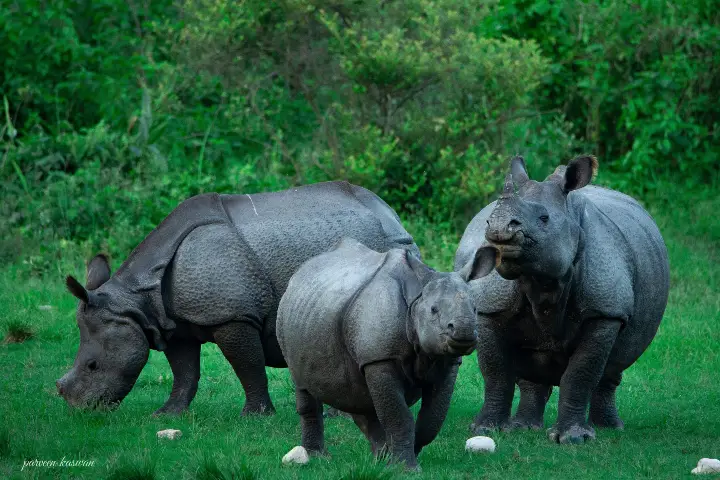

The horns of rhino including the Indian one-horned have got reduced over a period of time due to poaching (Pic. Courtesy Twitter/@ParveenKaswan)
Human actions are impacting the environment and nature in several ways, including how animals are evolving. This aspect came to the fore when it was found rhinoceros horns are becoming smaller as per an article in newscientist.com because of relentless poaching of these creatures.
The reason for the continuous killing of rhinos is for the horns which are viewed as trophies while they fetch a very high price for being an ingredient in the traditional Chinese and Vietnamese medicines.
Now killing for the biggest of the horns since they are valued very high may have bettered chances of survival for those with smaller ones and encouraged the birth of more rhinos with smaller horns. This hypothesis, said zoologist Oscar Wilson from Finland’s University of Helsinki, is backed by the analyses of many images clicked during a period of more than 100 years.
Commenting on this Wilson said: “This is bad news for hunters obviously, but unfortunately it’s bad news for rhinos as well, because if the hunters want the same amount of horn, they’re going to have to shoot more rhinos.”
Wilson and his colleagues were not able to access rhino horns since even those in museums are kept under lock and key. Hence, the team decided to analyse 80 profile-view pictures of living rhinos for a period from 1886 to 2019. These had been uploaded by experts on rhino from all over the world to the United Kingdom’s Rhino Resource Centre database.
Using software, the scientists worked out the different anatomical measurements for every animal and then approximated the size of the horn in proportion to the size of the body. Keeping in mind the fact that the size of the horn varies as per the species, the researchers made separate size charts for every type of rhino. These were the white rhino (Ceratotherium simum), the Indian rhino (Rhinoceros unicornis), the Javan rhino (Rhinoceros sondaicus), the Sumatran rhino (Dicerorhinus sumatrensis) and the black rhino (Diceros bicornis). Among these the last three are critically endangered.
A large number of the rhinos in the photos had been born in the wild but were now housed in sanctuaries, zoos and wildlife parks where they had been clicked. Only 12 of them were still living in the wild.
The horn sizes were mapped along a time chart and it was discovered that the size had decreased gradually in the case of every species. Though the data was not enough to zero on the exact percentage of the change in the size of the horns, what was evident was the downward trend. It was most pronounced in the Sumatran rhino, Wilson said.
The reduction in the size of horns because of poaching could adversely affect the behaviour and welfare of the rhinos, Wilson informed. “Rhinos do actually use their horns for a lot of different things, like defending their territory or finding a mate. We think [these reductions in horn sizes] must have some effect on the way rhinos will live their lives.”
While this may be a dismal scenario yet Wilson is hopeful on account of the changing attitude of people towards the rhinos. From the 1950s it has been found that from being depicted as fearsome beasts which were worth hunting, it is now turned a symbol of conservation.
“We’re viewing rhinos way more positively than we ever have. We think this is the real cause for optimism [concerning] rhino conservation,” Wilson remarked.
Details of the study were published in People and Nature.
Taiwan's military is prioritising combat readiness as a key aspect of deterrence due to escalating…
Calling for an increase in the speed of development, Prime Minister Narendra Modi said on…
The Scottish Government has reaffirmed its commitment to supporting religious freedom and human rights for…
Tara Chand Baloch, the President of the Baloch American Congress and a former Cabinet minister…
In a groundbreaking study, researchers from McGill University have identified nine biological markers in the…
India, in a firm and unequivocal statement at the United Nations Security Council (UNSC), accused…